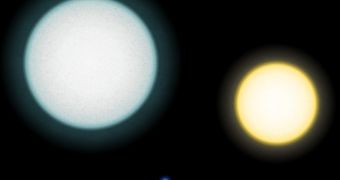According to the conclusions of a study presented on January 8 at the 223rd meeting of the American Astronomical Society (AAS) in Washington, DC, it would appear that Type Ia supernovae – powerful cosmic explosions that can briefly outshine entire galaxies – are produced by merging white dwarfs.
A white dwarf is the Earth-sized remnant of a Sun-sized star. It represents the final stage in a regular star's life cycle, and only develops after the object exits its main sequence, turns into a red giant, and then contracts into a helium-burning celestial orb.
Unlike Type II supernovae, which occur when massive stars at least 8 times heavier than the Sun explode, Type Ia event usually occur inside binary systems featuring at least one white dwarf. This led astronomers to propose a long time ago that the explosions were produced by these objects while accumulating mass from their companions.
This view may be wrong, Harvard-Smithsonian Center for Astrophysics (CfA) astronomer Robert Olling said at the AAS 2014 winter meeting. Evidences to support this claim were produced by the NASA Kepler Space Telescope, which experts use to find planets around distant stars.
During its mission, Kepler collected date once every 30 minutes, from a portion of the night sky that contained an estimated 150,000 stars. During his survey of telescope data, which cover 400 galaxies in its field of view, Olling found two Type Ia supernovae, and was able to observe them in great detail.
According to previous suggestions, if these explosions occurred in binary systems featuring a white dwarf and a red giant, then the blasts would produce shock waves that would throw material into the companion star. In turn, the brightness of the red giant would increase considerably, Nature News reports.
In Kepler date, this significant increase would generate a rather large blimp. No such blimp has been detected during the two events Olling and colleague Robert Kirshner, also with CfA, studied.
One of the reasons why previous studies excluded the possibility that white dwarf mergers caused Type Ia supernovae was that the process is slow-going. However, more recent data suggest that these small stars can merge within minutes or seconds, rather than millennia, as suggested in the past.

 14 DAY TRIAL //
14 DAY TRIAL //